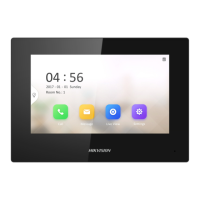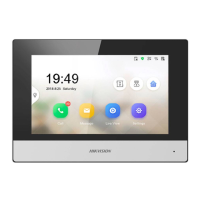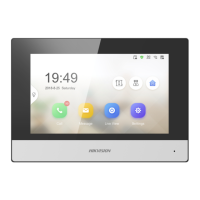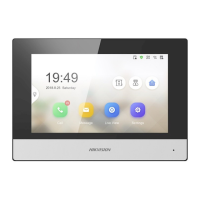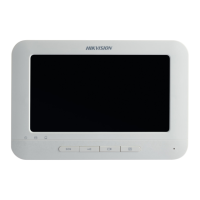
Do you have a question about the HIKVISION DS-KH6310-W and is the answer not in the manual?
| Color | Yes |
|---|---|
| Certification | FCC, IC, CE, C-TICK, ROHS, REACH, WEEE |
| Number of buttons | 4 buttons |
| Connectivity technology | Wired |
| Sustainability certificates | RoHS |
| Voice codecs | G.711u |
| Display diagonal | 7 \ |
| Display resolution | 800 x 480 pixels |
| Display technology | LCD/TFT |
| Indoor unit power type | AC/DC |
| Power consumption (typical) | 10 W |
| Operating relative humidity (H-H) | 10 - 90 % |
| Main monitor station operating temperature (T-T) | -10 - 55 °C |
| Proper use | Indoor |
| Control type | Buttons, Touch |
| Product color | White |
| Operating system installed | Linux |
| Wi-Fi standards | 802.11b, 802.11g, Wi-Fi 4 (802.11n) |
| Cabling technology | 10/100Base-T(X) |
| Ethernet LAN data rates | 10, 100 Mbit/s |
| Ethernet interface type | Fast Ethernet |
| Ethernet LAN (RJ-45) ports | 1 |
| Supported network protocols | TCP/IP, RTSP |
| Depth | 26 mm |
|---|---|
| Width | 217 mm |
| Height | 142 mm |
Information regarding Hikvision and other registered trademarks used in the manual.
Details limitations of warranties and the user's responsibility for manual usage.
Compliance and operating conditions related to FCC regulations for the device.
Details conformity with European standards and directives (CE, WEEE, RoHS).
States compliance with Industry Canada's ICES-003 standards.
Critical safety precautions; neglecting them may lead to serious injury or death.
Important safety precautions; neglecting them may lead to injury or equipment damage.
Introduces the video intercom system and its primary applications.
Lists the key functionalities and capabilities of the indoor station.
Details the front and rear panel layout of the DS-KH8501-WT and DS-KH8500-T models.
Details the front panel layout and components of the DS-KH8301-WT and DS-KH8300-T models.
Details the front and rear panel layout of the DS-KH6310-W and DS-KH6310 models.
Details the front and rear panel layout of the DS-KH6310-W(L) and DS-KH6210(L) models.
Describes the rear panel connections and interfaces for DS-KH8501-WT/DS-KH8500-T.
Describes the rear panel connections and interfaces for DS-KH8301-WT/DS-KH8300-T.
Describes the rear panel connections and interfaces for DS-KH6310-W/DS-KH6310.
Describes the rear panel connections and interfaces for DS-KH6310-W(L)/DS-KH6210(L).
Guides on physically mounting the indoor station unit to a wall.
Provides the physical dimensions for the indoor station installation plate.
Details the steps for wall mounting the indoor station using a gang box.
Explains the electrical connections required for indoor stations.
Illustrates the wiring diagram for DS-KH8501-WT/DS-KH8500-T/DS-KH8301-WT/DS-KH8300-T.
Illustrates the wiring diagram for DS-KH6310-W/DS-KH6310.
Illustrates the wiring diagram for DS-KH6310-W(L)/DS-KH6210(L).
Guides on defining the hierarchical structure of communities, buildings, floors, and rooms.
Details the process for activating and configuring online indoor stations using the setup tool.
Explains how to activate devices remotely using the batch configuration software.
Guides on modifying network settings like IP address for online devices.
Covers various methods for adding devices to the configuration software.
Describes how to add devices discovered on the local network.
Explains adding devices by specifying IP address, IP segment, or port number.
Provides options for remote management and configuration of device parameters.
Covers system-level remote settings like device info, time, and maintenance.
Details settings related to video intercom functionality, including device and time parameters.
Guides on configuring local and linked network settings for devices.
Configures general system parameters within the iVMS-4200 software.
Covers managing devices within iVMS-4200, including activation and remote configuration.
Organizes devices by creating and assigning them to groups.
Explains the process of creating new groups for device organization.
Manages access cards for residents and visitors, including adding and issuing.
Covers the process of adding and managing unauthorized access cards.
Allows creating and sending notices to residents via the system.
Guides on composing and sending informational notices to residents.
Provides functionality to view historical call records.
Allows users to view logs of door unlocking events.
Manages the security arming status of the indoor station.
Guides on activating the indoor station directly through its user interface.
Explains the layout and functionality of the indoor station's graphical user interface.
Details the different screens and icons of the indoor station's user interface.
Explains the meaning of various status icons displayed for the indoor station.
Explains the meaning of status icons relevant to indoor extensions.
Describes how to set and view the arming status (sleeping, custom, indoor, outdoor).
Provides access to configure various device settings.
Allows modification of admin, duress, unlock, and arm/disarm passwords.
Configures ringtone, ring duration, volume, touch sound, and auto-answer.
Enables 'Do Not Disturb' modes, either All Day or Scheduled.
Configures arming modes such as outdoor, indoor, sleeping, and custom.
Sets up alarm zones, including zone type, alarm mode, and delay times.
Manages system functions like TF card formatting, screen clearing, rebooting, and upgrades.
Configures local information, network, device management, and time synchronization.
Configures room number, video standard, and live view duration.
Configures the device's network connection settings, including IP address.
Configures the connection to a SIP server for inter-device communication.
Guides on connecting external devices like door stations and IP cameras.
Details the process for adding a main door station to the system.
Connects the indoor station to a security control panel for alarm event uploads.
Synchronizes the device's clock with NTP servers.
Manages call-related functions, including contacts and call logs.
Allows adding new contacts to the device's contact list.
Initiates video calls to residents by their room number.
Describes how to answer incoming calls from door stations or the management center.
Displays a history of missed calls and all calls.
Enables calling the management center and elevator system.
Manages system information such as notices, visitor messages, and logs.
Displays records of alarm events detected by the system.
Shows logs of captured images from the system.
Allows real-time monitoring of connected door stations and IP cameras.
Provides important advice regarding the spacing between installed devices.
Lists the types and specifications of cables used for installation.
Detailed technical specifications for the DS-KH8501-WT and DS-KH8500-T models.
Detailed technical specifications for the DS-KH8301-WT and DS-KH8300-T models.
Detailed technical specifications for the DS-KH6310-W and DS-KH6310 models.
Detailed technical specifications for the DS-KH6310-W(L) and DS-KH6210(L) models.

